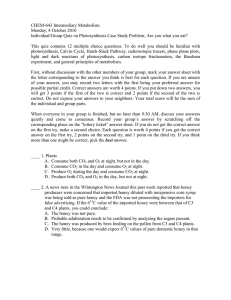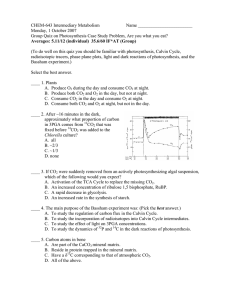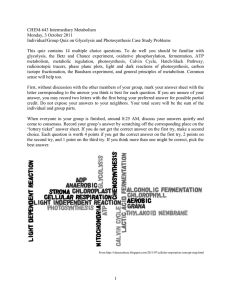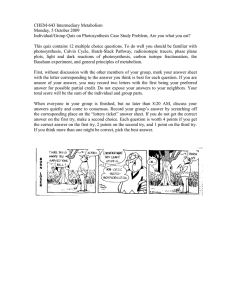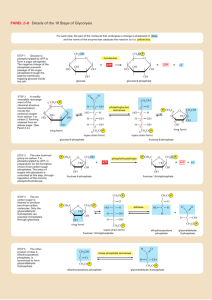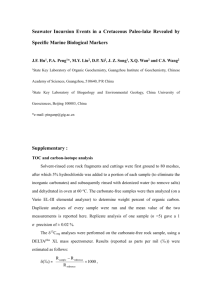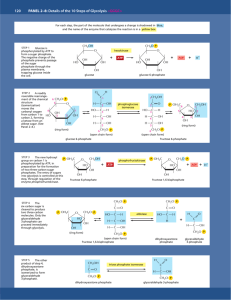CHEM-643 Intermediary Metabolism Monday, 30 September 2013
advertisement
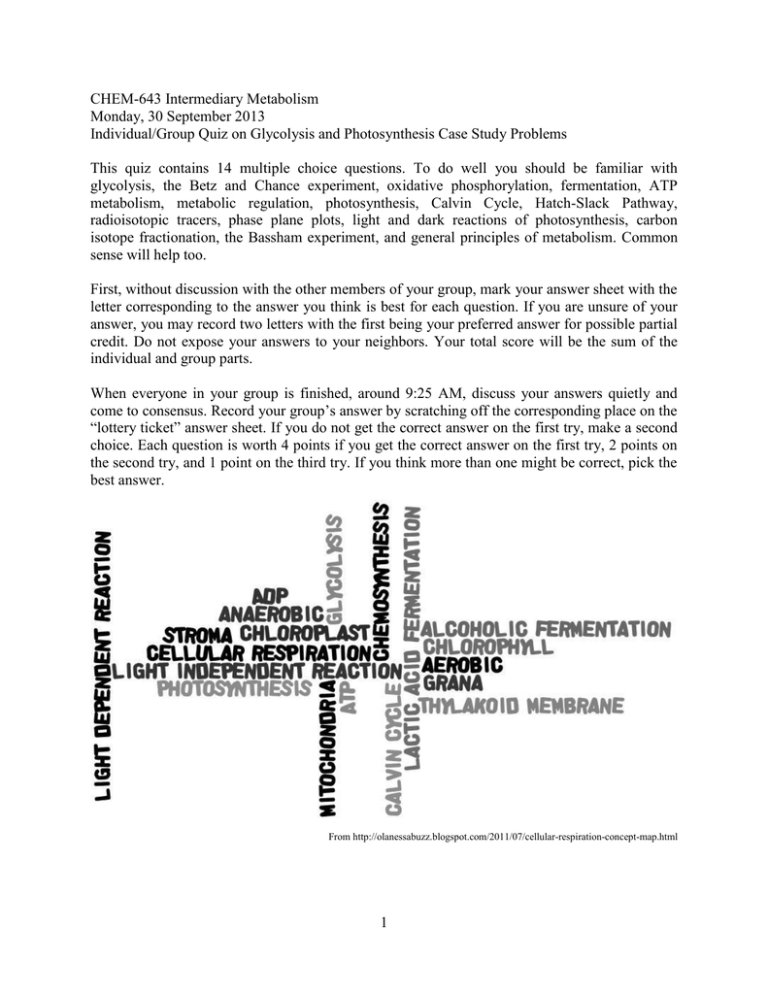
CHEM-643 Intermediary Metabolism Monday, 30 September 2013 Individual/Group Quiz on Glycolysis and Photosynthesis Case Study Problems This quiz contains 14 multiple choice questions. To do well you should be familiar with glycolysis, the Betz and Chance experiment, oxidative phosphorylation, fermentation, ATP metabolism, metabolic regulation, photosynthesis, Calvin Cycle, Hatch-Slack Pathway, radioisotopic tracers, phase plane plots, light and dark reactions of photosynthesis, carbon isotope fractionation, the Bassham experiment, and general principles of metabolism. Common sense will help too. First, without discussion with the other members of your group, mark your answer sheet with the letter corresponding to the answer you think is best for each question. If you are unsure of your answer, you may record two letters with the first being your preferred answer for possible partial credit. Do not expose your answers to your neighbors. Your total score will be the sum of the individual and group parts. When everyone in your group is finished, around 9:25 AM, discuss your answers quietly and come to consensus. Record your group’s answer by scratching off the corresponding place on the “lottery ticket” answer sheet. If you do not get the correct answer on the first try, make a second choice. Each question is worth 4 points if you get the correct answer on the first try, 2 points on the second try, and 1 point on the third try. If you think more than one might be correct, pick the best answer. From http://olanessabuzz.blogspot.com/2011/07/cellular-respiration-concept-map.html 1 CHEM-643 Intermediary Metabolism Glycolysis-Photosynthesis Quiz 30 September 2013 ___ 1. The figure below on the left shows the changes in concentration of Glyceraldehyde 3 Phosphate (GAP) with respect to NADH (fluorescence) in glycolyzing yeast following an abrupt shift from aerobic to anaerobic conditions. The figure on the right shows the reactions involving GAP and NADH in yeast. Consider points 3 – 6 on the phase plane plot. They indicate that: A. GAP production is in phase with NADH production. B. NADH is being produced as fast as it is consumed. C. GAP is being produced but not being converted to 1,3 diphosphoglycerate. D. NADH is neither being consumed nor produced. ___ 2. If one were to measure the amount of ethanol in the yeast suspension at time points 1-13 of the phase-plane plot in Question 1, one would find that the concentration of ethanol would: A. Remain constant B. Decrease C. periodically increase and decrease D. Increase ___ 3. Inhibition of the production of acetaldehyde in yeast prevents the normal fermentation process. Instead yeast produce glycerol as a fermentation product by the reactions shown below with the cofactors and other reactants and products omitted. A. B. C. D. Reaction 1 is a kinase Reaction 1 is a transferase Reaction 2 is a hydrolase Reaction 2 is a dehydrogenase 2 CHEM-643 Intermediary Metabolism Glycolysis-Photosynthesis Quiz 30 September 2013 ___ 4. When the substrate oscillations eventually stop after the abrupt +O2 to –O2 transition in a yeast suspension, the following is true: A. Phosphofructokinase is strongly inhibited by ATP. B. The rate of glucose utilization is half the rate of pyruvate formation. C. Glycolysis stops. D. Oxidative phosphorylation resumes. ● 0 ____ 6. The point on the graph to the right represents the concentrations of Ru5P and RuBP at the moment the lights were turned off in Bassham’s experiment. Plot the point corresponding to their concentrations about 30 sec later when [3PGA] peaks. The new point’s location is: A. above and to the left B. above and to the right C. below and to the left D. below and to the right [Ru5P] ___ 5. In Question 3, if carbon 1 (top in the figure) were labeled with 14C, the label would appear where in the glycerol? A. Top B. Middle C. Bottom D. top and bottom equally 0 [RuBP] ___ 7. The figure at the right from the Bassham experiment tracks the 32P and 14C in 3-Phosphoglycerate (3PGA) in a Chlorella suspension as a function of time after a light to dark transition in the presence of 32Pi and 14CO2. Before the light is turned off, the amounts of 32P and 14 C in 3-phosphoglcerate (3PGA) are not changing. During this period which is not correct?: A. Some molecules of 3PGA contain both 32P and 14C. B. In any one molecule of 3PGA, there could be 1, 2, or 3 labeled carbons. C. There are many PGA molecules that contain neither radioactive isotope. D. There are two separate pools of 3PGA, one that contains 32P and the other than contains 14C. ___ 8. The steep, almost instantaneous, rise in 3PGA (see fig in Q7) can be attributed to: A. The increased rate of synthesis of 3PGA. B. The lack of NADPH to generate GAP. C. The lack of ATP to make 1,3 DPGA (1,3 diphosphoglycerate). D. The lack of ATP to form RuDP (ribulose 1,5 bisphosphate). 3 CHEM-643 Intermediary Metabolism Glycolysis-Photosynthesis Quiz 30 September 2013 ____ 9. The amount of the immediate increase in 32P 3PGA would be. A. Dependent on the production of ATP by dark reactions B. More or less stoichiometric to the RuDP present when the lights were turned off. C. Due to an increase in the amount of free 32P-phosphate available. D. Caused by activation of the glycolytic pathway. ____ 10. Consider two identical photosynthesizing leaves of a C4 plant (e.g. corn plant) placed in separate vessels containing air at atmospheric CO2 concentrations. Vessel 1 is sealed so new air cannot come in, while the Vessel 2 remains open to the air. Photosynthesis is allowed to continue until the CO2 in Vessel 1 is used up. What can you predict about the δ13C values for newly fixed carbon? A. B. C. D. δ13C atmospheric CO2 = δ13C Vessel 1 > δ13C Vessel 2 δ13C atmospheric CO2 > δ13C Vessel 1 > δ13C Vessel 2 δ13C atmospheric CO2 < δ13C Vessel 1 < δ13C Vessel 2 δ13C atmospheric CO2 = δ13C Vessel 1 < δ13C Vessel 2 ___ 11. Plants A. Consume CO2 in the day and consume O2 at night. B. Consume both CO2 and O2 at night, but not in the day. C. Produce O2 during the day and consume CO2 at night. D. Produce both CO2 and O2 in the day, but not at night. ____ 12. The curve at the right displays the amount of 14CO2 remaining in the atmosphere as the result of atmospheric atomic bomb testing in the 1950s and 60s. If a 100 year old tree were cut down in 2005 and the 14C content of each annual growth ring was measured and plotted, the resulting graph of 14C vs time would: A. Be flat corresponding to the highest point in 1968. B. Be flat corresponding to 2005 levels. C. Look much like the graph at the right. D. Look like a saturation curve with highest values in 2005. 4 CHEM-643 Intermediary Metabolism Glycolysis-Photosynthesis Quiz 30 September 2013 CHO CHO 2 GAP GAP CH2OH C O CH2O P 1 B CH2O P C O HO C H H C OH H C OH CH2O P A 3 4 CH2OH C O HO C H H C OH H C OH CH2O P 2 CHO H C OH H C OH CH2O P Conversion of 5 molecules of glyceraldehyde-3-P (GAP) into 3 molecules of ribulose-5-P (Ru5P) in the "carbon scamble" portion of the Calvin Cycle. 5 HO H H H CH2OH C O HO C H H C OH CH2O P CH2O P GAP GAP CH2OH C O CH2O P D C 5 GAP H C OH CH2O P CH2O P GAP CHO H C OH H C OH CH2O P CH2O P CHO CHO H C OH H C OH B CHO H C OH H C OH H C OH CH2O P 7 CH2O P C O C H C OH C OH C OH CH2O P 6 F HO H H H CH2OH C O C H C OH C OH C OH CH2O P G 9 E H CH2OH C O HO C H H C OH CH2O P 9 CH2OH C O H C OH H C OH CH2O P Ru5P 8 E CH2OH C O H C OH H C OH CH2O P CH2OH C O H C OH H C OH CH2O P Ru5P Ru5P 3 Ru5P ____ 13. NaBH4 irreversibly inhibits lysine-dependent aldolases. Which of the following reactions in the above diagram would be inhibited by this treatment? A. 2 & 6 B. 1 & 5 C. 4 & 8 D. 3 & 7 ____ 14. Which compound is the first to react with CO2 in a C4 plant via the Hatch-Slack Pathway? A. B. C. 5 D.
